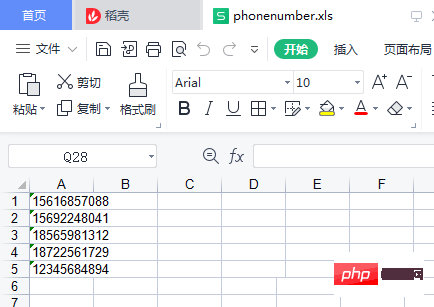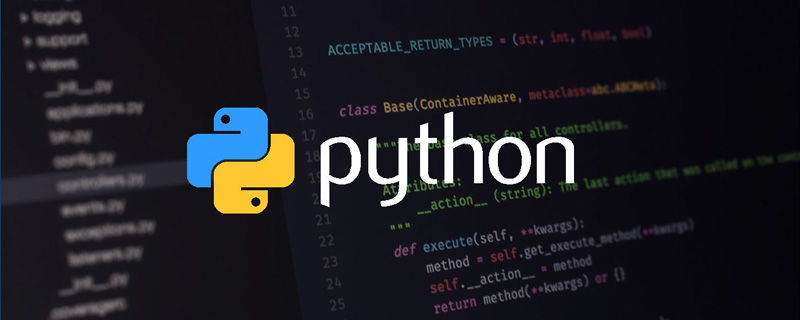 Backend Development
Backend Development
 Python Tutorial
Python Tutorial
 Let's talk about python file data analysis, management and extraction
Let's talk about python file data analysis, management and extraction
Let's talk about python file data analysis, management and extraction
[Related recommendations: Python3 video tutorial]
Prerequisite summary
Python2.0 cannot be read directly The problem of taking the Chinese path requires writing another function. python3.0 cannot be read directly in 2018.
When I use it now, I find that python3.0 can directly read Chinese paths.
You need to bring or create several txt files. It is best to write some data in them (name, mobile phone number, address)
Required
Writing code The best time is to set a few requirements yourself and clarify the following goals:
- Need to read all corresponding files in the corresponding directory path
- Read each corresponding file line by line txt file records
- Use regular expressions to get the mobile phone number of each row
- Save the mobile phone number into excel
Ideas
- 1) Read the file
- 2) Read the data
- 3) Data sorting
- 4) Regular expression matching
- 5) Data go Re
- 6) Data export and save
Code
import glob
import re
import xlwt
filearray=[]
data=[]
phone=[]
filelocation=glob.glob(r'课堂实训/*.txt')
print(filelocation)
for i in range(len(filelocation)):
file =open(filelocation[i])
file_data=file.readlines()
data.append(file_data)
print(data)
combine_data=sum(data,[])
print(combine_data)
for a in combine_data:
data1=re.search(r'[0-9]{11}',a)
phone.append(data1[0])
phone=list(set(phone))
print(phone)
print(len(phone))
#存到excel中
f=xlwt.Workbook('encoding=utf-8')
sheet1=f.add_sheet('sheet1',cell_overwrite_ok=True)
for i in range(len(phone)):
sheet1.write(i,0,phone[i])
f.save('phonenumber.xls')Running result

will generate an excel File


Analysis
import glob import re import xlwt
globe is used to locate the file, re regular expression, xlwt is used for excel
1) Read files
filelocation=glob.glob(r'课堂实训/*.txt')
All txt files in the specified directory
2) Read data
for i in range(len(filelocation)): file =open(filelocation[i]) file_data=file.readlines() data.append(file_data) print(data)
Read the txt files in the path in a loop , read the files sequentially by serial number
Open the file corresponding to each cycle
Read the data of the txt file for each cycle line by line
Use the append() method to add the data of each line to data
Output in the list, you can see that several txt file data exist in the same list in the form of character columns
3) Data sorting
combine_data=sum(data,[])
The lists are merged into one list
4) Regular expression matching plus data deduplication
print(combine_data)
for a in combine_data:
data1=re.search(r'[0-9]{11}',a)
phone.append(data1[0])
phone=list(set(phone))
print(phone)
print(len(phone))set() function: Unordered deduplication, create an unordered set of non-repeating elements
6) Data export and save
#存到excel中 f=xlwt.Workbook('encoding=utf-8') sheet1=f.add_sheet('sheet1',cell_overwrite_ok=True) for i in range(len(phone)): sheet1.write(i,0,phone[i]) f.save('phonenumber.xls')
- ##Workbook('encoding=utf-8'): Set the encoding of the workbook
- add_sheet(' sheet1',cell_overwrite_ok=True): Create the corresponding worksheet
- write(x,y,z):The parameters correspond to rows, columns, and values
Python3 video tutorial】
The above is the detailed content of Let's talk about python file data analysis, management and extraction. For more information, please follow other related articles on the PHP Chinese website!

Hot AI Tools

Undresser.AI Undress
AI-powered app for creating realistic nude photos

AI Clothes Remover
Online AI tool for removing clothes from photos.

Undress AI Tool
Undress images for free

Clothoff.io
AI clothes remover

AI Hentai Generator
Generate AI Hentai for free.

Hot Article

Hot Tools

Notepad++7.3.1
Easy-to-use and free code editor

SublimeText3 Chinese version
Chinese version, very easy to use

Zend Studio 13.0.1
Powerful PHP integrated development environment

Dreamweaver CS6
Visual web development tools

SublimeText3 Mac version
God-level code editing software (SublimeText3)

Hot Topics
 Is there any mobile app that can convert XML into PDF?
Apr 02, 2025 pm 08:54 PM
Is there any mobile app that can convert XML into PDF?
Apr 02, 2025 pm 08:54 PM
An application that converts XML directly to PDF cannot be found because they are two fundamentally different formats. XML is used to store data, while PDF is used to display documents. To complete the transformation, you can use programming languages and libraries such as Python and ReportLab to parse XML data and generate PDF documents.
 What is the process of converting XML into images?
Apr 02, 2025 pm 08:24 PM
What is the process of converting XML into images?
Apr 02, 2025 pm 08:24 PM
To convert XML images, you need to determine the XML data structure first, then select a suitable graphical library (such as Python's matplotlib) and method, select a visualization strategy based on the data structure, consider the data volume and image format, perform batch processing or use efficient libraries, and finally save it as PNG, JPEG, or SVG according to the needs.
 Is there a mobile app that can convert XML into PDF?
Apr 02, 2025 pm 09:45 PM
Is there a mobile app that can convert XML into PDF?
Apr 02, 2025 pm 09:45 PM
There is no APP that can convert all XML files into PDFs because the XML structure is flexible and diverse. The core of XML to PDF is to convert the data structure into a page layout, which requires parsing XML and generating PDF. Common methods include parsing XML using Python libraries such as ElementTree and generating PDFs using ReportLab library. For complex XML, it may be necessary to use XSLT transformation structures. When optimizing performance, consider using multithreaded or multiprocesses and select the appropriate library.
 How to beautify the XML format
Apr 02, 2025 pm 09:57 PM
How to beautify the XML format
Apr 02, 2025 pm 09:57 PM
XML beautification is essentially improving its readability, including reasonable indentation, line breaks and tag organization. The principle is to traverse the XML tree, add indentation according to the level, and handle empty tags and tags containing text. Python's xml.etree.ElementTree library provides a convenient pretty_xml() function that can implement the above beautification process.
 Is the conversion speed fast when converting XML to PDF on mobile phone?
Apr 02, 2025 pm 10:09 PM
Is the conversion speed fast when converting XML to PDF on mobile phone?
Apr 02, 2025 pm 10:09 PM
The speed of mobile XML to PDF depends on the following factors: the complexity of XML structure. Mobile hardware configuration conversion method (library, algorithm) code quality optimization methods (select efficient libraries, optimize algorithms, cache data, and utilize multi-threading). Overall, there is no absolute answer and it needs to be optimized according to the specific situation.
 How to open xml format
Apr 02, 2025 pm 09:00 PM
How to open xml format
Apr 02, 2025 pm 09:00 PM
Use most text editors to open XML files; if you need a more intuitive tree display, you can use an XML editor, such as Oxygen XML Editor or XMLSpy; if you process XML data in a program, you need to use a programming language (such as Python) and XML libraries (such as xml.etree.ElementTree) to parse.
 How to convert XML files to PDF on your phone?
Apr 02, 2025 pm 10:12 PM
How to convert XML files to PDF on your phone?
Apr 02, 2025 pm 10:12 PM
It is impossible to complete XML to PDF conversion directly on your phone with a single application. It is necessary to use cloud services, which can be achieved through two steps: 1. Convert XML to PDF in the cloud, 2. Access or download the converted PDF file on the mobile phone.
 How to convert XML to PDF on your phone?
Apr 02, 2025 pm 10:18 PM
How to convert XML to PDF on your phone?
Apr 02, 2025 pm 10:18 PM
It is not easy to convert XML to PDF directly on your phone, but it can be achieved with the help of cloud services. It is recommended to use a lightweight mobile app to upload XML files and receive generated PDFs, and convert them with cloud APIs. Cloud APIs use serverless computing services, and choosing the right platform is crucial. Complexity, error handling, security, and optimization strategies need to be considered when handling XML parsing and PDF generation. The entire process requires the front-end app and the back-end API to work together, and it requires some understanding of a variety of technologies.






